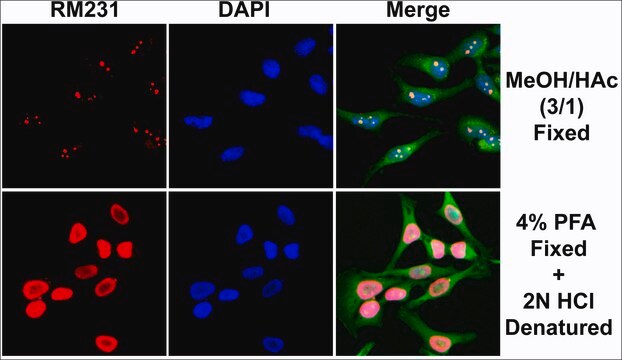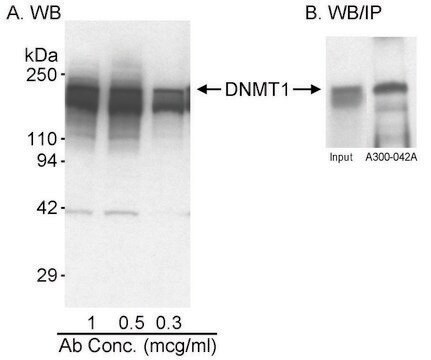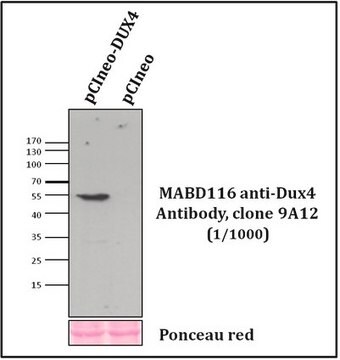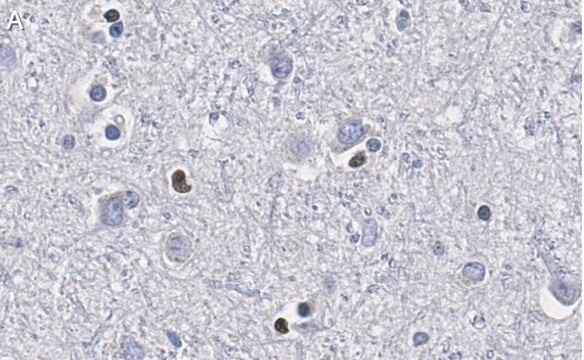MABE1081
Anti-5-Methylcytosine (5mC) Antibody, clone EDL MC-4
clone EDL MC-4, from mouse
Synonym(e):
5mC, 5-methylcytosine
About This Item
Empfohlene Produkte
Biologische Quelle
mouse
Qualitätsniveau
Antikörperform
purified immunoglobulin
Antikörper-Produkttyp
primary antibodies
Klon
EDL MC-4, monoclonal
Speziesreaktivität (Voraussage durch Homologie)
all
Methode(n)
dot blot: suitable
immunoprecipitation (IP): suitable
Isotyp
IgG2aλ
Versandbedingung
ambient
Posttranslationale Modifikation Target
unmodified
Allgemeine Beschreibung
Spezifität
Immunogen
Anwendung
Epigenetik & nukleäre Funktionen
Immunoprecipitation Analysis: 2.5 µg from a representative lot immunoprecipitated 5 ng of DNA with 5-methylcytosine (5mC) modification, but not DNA with only 5-hydroxymethylcytosine (5hmC) modification or unmodified cytosine (Courtesy of Jeong-Heon Lee, Ph.D.; Chad Clark; Tamas Ordog, M.D.; Zhiguo Zhang, Ph.D. Epigenomics Development Laboratory, Epigenomics Program, Center for Individualized Medicine, Mayo Clinic, Rochester, Minnesota, USA).
Qualität
Dot Blot Analysis: 2 µg/mL of this antibody detected 25-100 ng of DNA with 5-methylcytosine (5mC), exhibiting less than 25% cross-reactivity toward 5-formylcytosine (5fC) and no detectable immunoreactivity toward 5-hydroxymethylcytosine (5hmC), 5-carboxylcytosine (5caC), or unmodified cytosine.
Zielbeschreibung
Physikalische Form
Lagerung und Haltbarkeit
Sonstige Hinweise
Haftungsausschluss
Sie haben nicht das passende Produkt gefunden?
Probieren Sie unser Produkt-Auswahlhilfe. aus.
Lagerklassenschlüssel
12 - Non Combustible Liquids
WGK
WGK 1
Flammpunkt (°F)
Not applicable
Flammpunkt (°C)
Not applicable
Analysenzertifikate (COA)
Suchen Sie nach Analysenzertifikate (COA), indem Sie die Lot-/Chargennummer des Produkts eingeben. Lot- und Chargennummern sind auf dem Produktetikett hinter den Wörtern ‘Lot’ oder ‘Batch’ (Lot oder Charge) zu finden.
Besitzen Sie dieses Produkt bereits?
In der Dokumentenbibliothek finden Sie die Dokumentation zu den Produkten, die Sie kürzlich erworben haben.
Unser Team von Wissenschaftlern verfügt über Erfahrung in allen Forschungsbereichen einschließlich Life Science, Materialwissenschaften, chemischer Synthese, Chromatographie, Analytik und vielen mehr..
Setzen Sie sich mit dem technischen Dienst in Verbindung.








